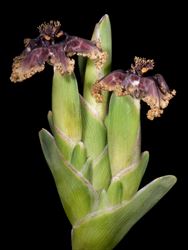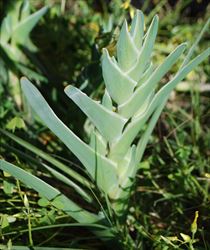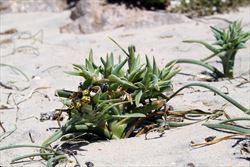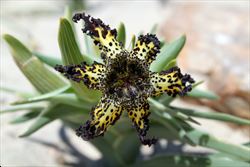Click on images to enlarge

Ferraria crispa, by Kevin Thiele (https://www.flickr.com/photos/66951228@N07/8691785781) https://creativecommons.org/licenses/by/2.0/

By SeanMack (Own work) [CC BY-SA 3.0 (http://creativecommons.org/licenses/by-sa/3.0)], via Wikimedia Commons

'Spider flower' (Ferraria crispa), Namaqualand, Northern Cape, South Africa, by flowcomm (https://www.flickr.com/photos/flowcomm/10634348544) https://creativecommons.org/licenses/by/2.0/

'Spider flower' (Ferraria crispa), Namaqualand, Northern Cape, South Africa, by flowcomm (https://www.flickr.com/photos/flowcomm/10634306344) https://creativecommons.org/licenses/by/2.0/

By SeanMack (Own work) [CC BY-SA 3.0 (http://creativecommons.org/licenses/by-sa/3.0)], via Wikimedia Commons
Scientific Name
Ferraria crispa Burm. subsp. crispa
Synonyms
Ferraria undulata L.
Family
Iridaceae
Common Names
black flag, spider flower, spider iris
Origin
Native to southern Africa (i.e. Cape Province in South Africa)
Naturalised Distribution
Widely naturalised in the temperate regions of southern Australia (i.e. in the south-western and western parts of Western Australia, in southern and western Victoria, and in the south-eastern and southern parts of South Australia). Also naturalised on Norfolk Island.
Notes
Black flag (Ferraria crispa subsp. crispa) is regarded as an environmental weed in Victoria and Western Australia and is currently listed as a priority environmental weed in at least one Natural Resource Management region. This species, which has escaped cultivation as a garden ornamental, seeds prolifically and also produces a system of underground stacked corms. It is often found growing in dense clumps and its reproductive capacity makes it difficult to eradicate once established.
Black flag (Ferraria crispa subsp. crispa) is currently of most concern in south-western Western Australia, from Perth inland to Pingelly and south to Cape Riche, where it invades coastal heaths, sand dunes and woodland plant communities (i.e. tuart, agonis and banksia woodlands). It is considered to be a threat to biodiversity in the Southwestern Ecoregion of Australia, and is listed as one of the ten most serious invasive garden plants that are still available for sale in Western Australia. Black flag (Ferraria crispa subsp. crispa) is also present in conservation areas (e.g. in Yanchep National Park) and remnant bushland in this state.
In South Australia, black flag (Ferraria crispa subsp. crispa) mainly becomes naturalised grows around old gardens and rubbish dumps. However, it has also been recorded in conservation areas (i.e. in Coorong National Park).

